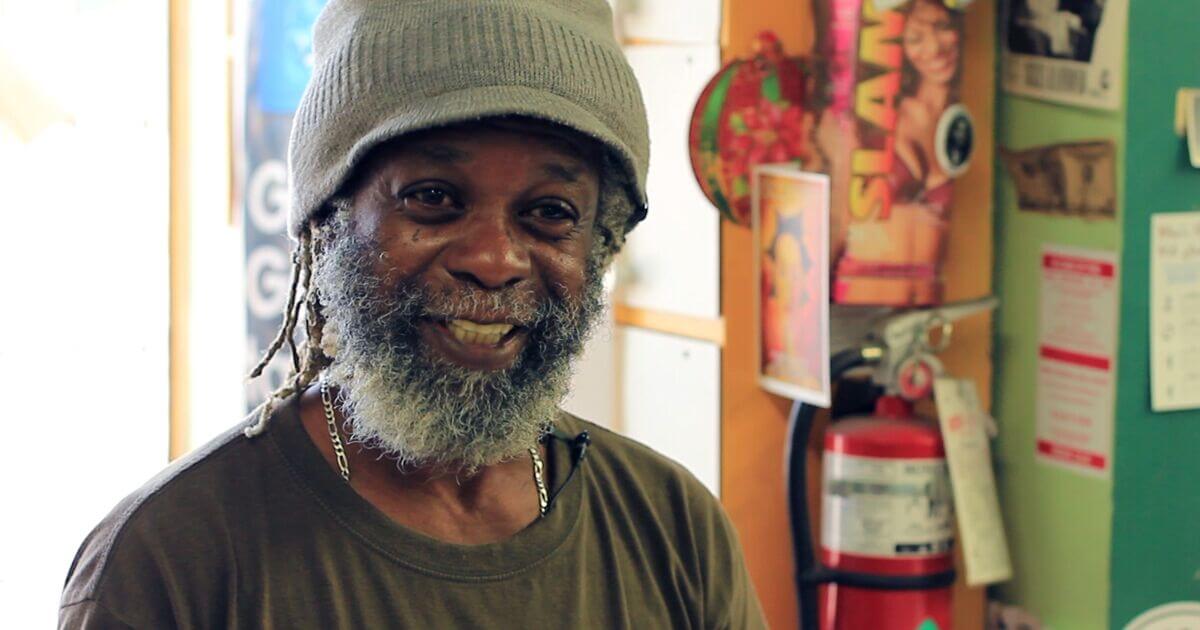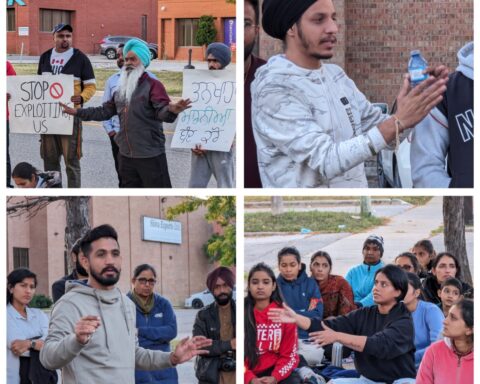“The World in Ten Blocks” is a two part documentary that offers viewers an in-depth look at one of the most diverse neighbourhoods in Toronto. Bloorcourt is home to a wide range of immigrants from across the world, which is inherently reflected in the small businesses that line its busy streets. Marc Serpa Francoeur and Robinder Uppal originally moved into the community back in 2011 while studying Documentary Media at Ryerson University. Inspired by residents’ stories of resilience, they created a linear film, as well as a virtual tour that allows users to interact with shop owners. New Canadian Media conducted an interview with the two filmmakers via email.
Q: What were the biggest influences behind your decision to study Documentary Media?
A: Documentary has been a long-standing interest of ours going back to high school in the early 2000s, where we made our first short doc for a school project. As our interests in social justice, politics, and environmental issues evolved and deepened, documentary film increasingly emerged as the ideal form to bring together our varied skills and passions, including creative writing, journalism, videography, and photography. Moving into documentary work in the online sphere has only broadened these syncretic possibilities.
Q: The interactive tour provides a very unique experience, where did the inspiration for this idea come from?
A: As the children of immigrants, many of the themes explored in the project have long been close to our hearts. “The World in Ten Blocks” actually began as our joint thesis work in the Documentary Media MFA program at Ryerson University in Toronto, for which we originally moved to the city. The documentary is set in the community where we both lived when we started the project, and having gotten to know a few of the immigrant small business owners in the neighbourhood and heard their incredible stories, the idea for the project started to percolate. After producing a 34 min linear film, we began working in earnest on the interactive experience after graduation in mid-2013.
Two of the main underlying motives with this project are to share the diversity of the neighbourhood and to honour the immigration experiences of some of its small business owners. After experiencing projects like Hollow, Welcome to Pine Point, and others, we decided that an interactive documentary would be be the most compelling way to situate those stories in an engaging, user-driven exploration of the geography and history of the neighbourhood.
Q: There seemed to be a lot of thought and hard work that went into the project with Robinder even learning how to code, what would each of you say were the biggest challenges of the project and why?
A: As a basically self-funded project (i.e. thousands of hours of own labour with virtually no financial support), we had no choice but to develop a wide range of skills and manage a workload between the two of us that would normally be carved up among various specialists. Most notable, was that in order to make the project possible, one of us (Robinder) taught himself to code from scratch (e.g. HTML, CSS and JavaScript); a gargantuan, but ultimately gratifying endeavour.
Making the documentary is just one part of the process; finding an audience is a huge challenge in its own right, and often even the best-funded work falls very flat in this area. As independent producers working in the still relatively unknown realm of interactive doc, we felt that a “media partner” with an established audience who could promote and distribute the project would be a huge hand up for us. Looking at the Canadian media landscape, The Globe and Mail seemed the best fit, especially because we wanted to reach audiences not just in Toronto but across the country. As emerging creators without much of a track record, we were fortunate that the folks at The Globe were willing to give us a chance, especially given the lack of precedent for a partnership like ours (i.e. it’s the first major interactive documentary they’ve hosted). While they didn’t fund the project, we see a lot of potential for independent creators and media organizations, big and small, to partner in the delivery of in-depth documentary content that goes far beyond the scope of traditional news coverage.
Q: There are small mentions of the negative effects large corporations have on small businesses, most evident with “Wire’s Variety” which was closed by the time the documentary was released. In your opinion, what can the city do to support Bloorcourt’s independent businesses?
A: From our perspective, some of the most serious structural challenges for independent small businesses in Bloorcourt and throughout Toronto are problems that the city could go a long way toward addressing. Most notable is the lack of commercial rent control, combined with the ability of landlords to decline to renew leases entirely at their own discretion. The city has the capacity to address both of these concerns, and failing to do so will have serious consequences for our communities.
As real estate prices rise, there’s often nothing that prevents a landlord from dramatically increasing the rent from one lease cycle to the next. This is a very real threat for all of the city’s small businesses who rent and do not own the properties where they operate. Without some measure of rent control for commercial leases—which, keep in mind, is found in some jurisdictions—runaway commercial rents will lead to increasing numbers of downtown Toronto storefronts taken up by corporate chains, destroying the diverse character of neighbourhoods like Bloorcourt.
Unlike with residential tenancy, a commercial landlord can simply refuse to renew a lease at their discretion, despite the considerable investment that a tenant may have made to improve the space, building a customer base, etc. Just this past weekend (May 27th), one of the participant businesses in the project, Courense Bakery, closed suddenly when their landlord refused to renew their lease (apparently because they intend to sell the building). This is a big blow not only for the owners and staff, but for the neighbourhood as a whole, whose successive generations have patronized that bakery for some 35 years.
In addition, we also found out this week that participant business Pam’s Roti will be forced to relocate (for the third time), as her landlord is refusing to renew her lease, ostensibly because he intends to install a Subway franchise in the same space. Pam and her husband have invested tens of thousands of dollars in improvements and renovations to the space, and it remains to be seen whether the landlord will compensate them. This touches on a third major issue, which is that very often small businesses lack strong legal counsel when it comes to designing the terms of their lease. Furthermore, it’s not uncommon for a tenant to be too intimidated to pursue damages in court, given the generally more substantial financial resources of the landlord. The city could contribute to addressing these power dynamics by providing an ombudsman or legal advisor to review leases, a collection of resources/guides, or other types of legal support for small businesses.
Q: What is the most important lesson you took away from this experience and why?
A: Working on “The World in Ten Blocks” over the last five years has been a profound and life-changing experience for both of us, and we’ve learned lessons about a great many things along the way. We learned early on that things which seem stable can change very rapidly. For example, the closure of Wire’s Variety took us by surprise—we were out of town for a few weeks and returned to a business shuttered after 33 years—and putting Wire’s story together was far more difficult because of that. The overarching lesson for us as documentary filmmakers has been to never take for granted the ability to come back and film another day.
Q: What are some other upcoming projects people should look out for?
A: A new project that we’re about a year and a half into focuses on a police abuse incident and its legal aftermath. It’s set in Calgary, which is where we’re from originally. The vision is for a serialized multimedia web piece that will be more reportage and a less immersive experience than Ten Blocks, although there’s something of a through-line content-wise as the victim is a young immigrant. Our concept is to offer various levels of engagement: short videos that cover the main beat of a given instalment, with more expansive materials (documents, audio-visuals, etc.) for those that want to dive deeper. In some ways, the project feels like an obvious direction for us as we’ve long been interested in exploring the shortcomings of our civic institutions, and feel that narrowing in on this particular story will shed light on some of the profound dysfunction of a law enforcement and legal system that lacks fundamental safeguards to prevent the abuse of power.
We also just launched the last installment of League of Exotique Dancers Interactive, the interactive companion piece to the feature doc of the same name that opened Hot Docs 2016. This project presented a different challenge in that we were hired hands who were handed an existing body of material to work with (video, personal archives, score, etc.) and asked to come up with something compelling… which we think we did!
Also, in terms of the future of The World in Ten Blocks, the project has been invited to the prestigious Sheffield Doc/Fest in the UK, which is exciting because it has long been a goal for us to share the diversity and relatively high degree of inclusivity that we enjoy here in Toronto with audiences in Europe. The project will continue to be exhibited at a number of local events, galleries, and festivals, including a six-week installation as part of Making Peace (a multi-year international traveling exhibition) that will be up until the end of June.
One thing that has always been very important to us is to have the project seen and used in schools. To that end, we’re really excited to have embarked on an ambitious outreach and knowledge mobilization program that focuses on junior and senior high school students, and utilizes the project to explore diversity, foster inclusivity, and engender appreciation for the historical contribution of immigrant communities to Toronto. We have some stellar collaborators on board who will take the helm to produce an educational guide for use in the classroom, and develop educator- and community-oriented workshops and presentations. We’ve even had a number of educators get in touch who have already started using the project in their classrooms going back to soon after the launch at the end of 2016, which is very exciting!
A business enthusiast with a passion for implementing processes that improve the world around me.





